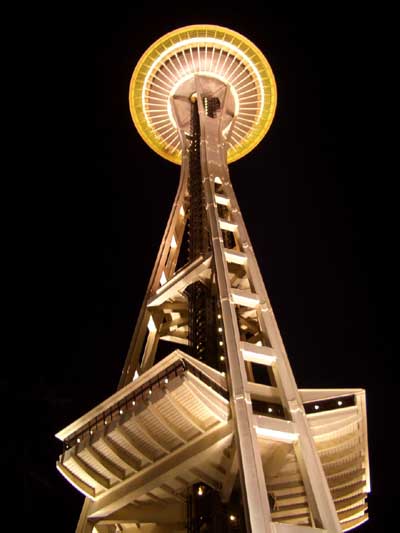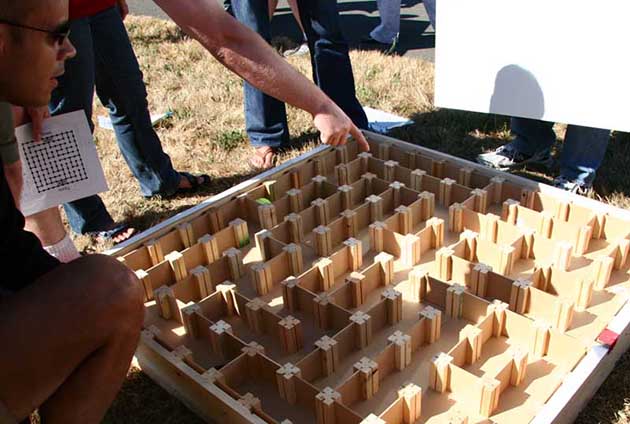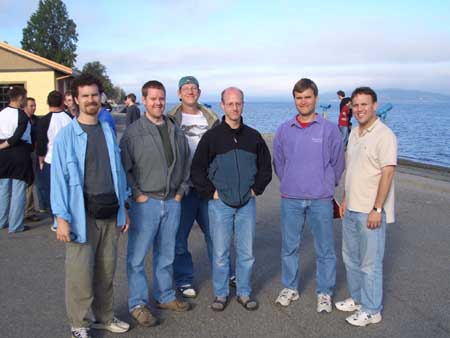We’ve just started the third leg of the Game and already we are floundering.
Our current task is to venture into an enormous corn maze and locate 14 signs placed amongst the paths. Each sign bears a letter; collecting all the letters will spell out the location of the next clue.
There is also a large map of the maze posted near its entrance, but it’s too Byzantine to commit to memory. Some players are taking photos of it with their cell phones; the more sophisticated teams are sending all but one of their players into the maze armed with walkie-talkies, and stationing the remaining player at the map so he can coordinate their search via radio.
The “B” Ark has walkie-talkies, but we accidentally left them in the van; at this point the van is so cluttered with paper, food wrappers, and flotsam from previous clues, that it would probably take us 20 minutes to find them anyhow. So we charge into the maze with no plan whatsoever.
“Oh, by the way,” Chip mentions casually as we enter, “I’m allergic to corn.”
“Seriously?” we ask.
“Yeah,” he replies in a wheezy voice. “Already my throat is, like, closing up.”
Gordon, as team captain, makes an executive decision. “OK,” he says, “you go wait in the van.”
Chip lurches off, leaving us with one less person to search the maze.
We blunder around as a group for a few minutes. It’s clear we need to come up with a strategy, but, lacking any form of remote communication, no strategy seems viable.
“OK,” Gordon finally says, “here’s what we’re going to do. Everyone run around and look for letters. Meet back here in 10 minutes.”
We sprint off in different directions. As soon as I’ve lost sight of the others it occurs to me that this is the worst of all possible plans. There’s nothing preventing all of us from covering the same ground, and 10 minutes is barely enough time to go from one side of the maze to the other, much less return.
Still, captain’s orders are captain’s orders. I run around wildly and eventually find two of the signs, jotting down the letters on each. Then I hurry back to the entrance, getting lost several times along the way.
Somehow we all arrive at the rendezvous point within seconds of one another. We compare notes. Incredibly—and I don’t mean that as a figure of speech—we are literally incredulous, rechecking our notes several times—we have gathered 13 of the 14 letters. Most other teams, at this point, have only collected six or so.
We deduce the final letter, solve the puzzle, and race back to the van. Chip is laying on the back seat, dead or asleep—there’s no time to determine which. We tear out of the parking lot in third place.
Our next stop is the Seattle Center in the heart of downtown. It’s not easy to find parking in this neighborhood, even at 2:00 a.m. on a Sunday morning, but we needn’t bother: As we pull up and pile out of the van a Galactic Consortium representative leaps inside and valet parks it on our behalf.

Again we are broken into smaller groups and sent off to tackle a variety of puzzles. After the “B” Ark has solved a total of four, we are given a set of plastic pieces and told to assemble them into a six-by-six-by-six cube. When completed, each side bears a letter, spelling out the answer. We whisper the code word into the ear of a GC rep, our van materializes from the early morning gloom, and we are back on the road in no time.
Comparing the next set of GPS coordinates to a map, I know immediately where we are headed: the Guild 45 movie theater in North Seattle. I presume that the clue will be taped to the outside of the box-office window. Instead we discover the theater open for business. Wandering in, we find Game Control behind the concession counter. They hand us popcorn and soda before ushering us into the theater.
Many players are already seated within, eyes riveted to the screen. We make our way to some empty seats, settle in, and turn our attention to the movie. It appears to be an old silent film: The people move in that jerky, slightly-too-fast manner that characterizes old films, and the only sound is a ’20s-era ragtime accompaniment.
There is never more than one person on the screen at any given time, and the actor or actress is always looking directly into the camera while gesturing. On screen is a young woman making motions as if she is washing a car, and then flexing her muscles while pointing to her biceps.
Bob is in the row ahead of me with pen and paper at the ready. I lean forward and say, “Buff. Write down ‘buff.’“
“Buff?” He says, squinting at the screen. “Are you sure?”
“Yes,” I reply. “She was my partner.”
A few moments later I am on the screen pantomiming “ocean.”
All of the footage is from Friday’s modified Charades game, in which players gave their clues directly into a video camera—and Game Control has edited it into a movie. Our job now is to identify the 30 words being acted out.
For years the Game was run concurrently in California and Washington State, with hardcore teams traveling up and down the West Coast to participate in both.
We sit through the movie over and over. One poor guy is giving a clue for “booty”; we watch him aggressively waggle his ass four times in 15 minutes. Finally, when we have guessed two-thirds of the words, we retreat to the lobby. Eventually we notice that the words can be paired up—“boot” and “booty,” “shin” and “ocean,” “buff” and “buffet”—where the second word in each set is the first plus the vocalization of a letter (e.g., boot + E = booty). That gives us 15 letters, and the location of the next clue is revealed.
It’s just before dawn when I get a hold of the Trade Representative for Starship Serenity.
“I’m in the market for drugs,” I tell him bluntly. “Do you have any hypercoke?”
“I have suntoad extract,” he replies. “But the only thing I’m looking for is Fendari ore.”
The “B” Ark is carrying no Fendari Ore. “But keep us in mind, the next time you want to do business,” I say.
There is a game-within-the-Game. At the start of every leg, each team receives a number of cards depicting the ill-begotten goods they have acquired during their travels: meteor beetles, truegold, XGender implants, and more. We gain more commodities whenever we solve a puzzle, and submit our accumulated cargo to Game Control at the end of each leg. Teams can increase their standing in the uppercase-Game based on the value of the wares they submit in the lowercase-game.
The key to success in the trading game is aggressive negotiation with the other teams. As the Trade Representative for the “B” Ark, I spend much of my time at clue sites and during the pitstops bartering with others, swapping Playalien magazines for unwanted berserker beams and striving to complete sets of telepathic cats.
This is the first Game to feature such an activity. In fact, this Game is unique in a number of ways: the pre-Game festivities on Friday night for instance, and the breaking of the Game into four legs, with pitstops in between. But to understand why Game Control has suddenly introduced these additional elements, we need to take a quick detour through recent Game history.
Though the exact origins of the Game are a bit hazy, its creation is generally attributed to one Joe Belfiore, who, along with a few of his Stanford classmates, ran a series of Game-ish events in the late ’80s. When Belfiore later took a job with Microsoft and moved to Washington State, the Game bifurcated: Joe relaunched the Game in Seattle while his colleagues perpetuated the Game in the Bay Area. For years the Game was run concurrently in two places, with hardcore teams traveling up and down the West Coast to participate in both.
I participate in a limbo competition, where I am supposed to read a series of words off the bottom of the bar as I go under it. I am, alas, the least limber person I know.
Though the structure remained similar, over time the tone of the two Games began to diverge. While the Bay Area Game continued as an intensive but essentially laid-back affair, the Seattle Game (or “Microsoft Game,” as it came to be known) grew ever more competitive. Not only were Seattle teams becoming obsessive about winning, but Game Control kept trying to outdo themselves, which eventually led to a number of Games that even Game aficionados describe as “completely over the top.” The 2001 Game had players venturing into a prison to retrieve a clue from an inmate, “flying” across the city in an actual MD-80 Alaska Airlines flight simulator, and finding a puzzle on the roof of the Space Needle. The entrance fee for each team was $25,000.
Then in 2002, disaster struck. A player in the Seattle Game was grievously wounded while searching for a clue in an abandoned mineshaft. When it came time to plan the 2003 game, everyone demurred—both out of respect for the injured player and concern for liability issues. When 2004 came and went without a Seattle Game, Seattle teams started to disband, and players began traveling to the Bay Area to get their annual Game fix.
With “The Mooncurser’s Handbook,” Game Control is trying to revive the moribund Seattle Game community; as such, they have made a number of alterations to the standard Game format, all in an attempt to increase interaction between participants. Teams must actively engage one another to do well in the trading game, everyone reunites and socializes during the pitstops, and there’s even a post-Game BBQ planned, where we can regale others with true tales of our intergalactic adventures.
A few longtime Game players dislike these new elements, but Game Control knew in advance they would not be to everyone’s liking. But I’m grateful for the breaks, and think the trading game is a blast.
After my conversation with Serenity I consider taking a nap, but instead look up the phone number for the Golden Nugget Trade Representative. Someone is bound to have some drugs for trade; I just need to figure out who.
At a 24-hour bowling alley we solve a puzzle by knocking down specific combinations of pins. Then we race around the city of Ballard using a Monopoly board as a map. We make little mistakes here, little mistakes there, and by the time we reach the pitstop we’re again in the back of the pack.
At the start of the fourth leg, I participate in a limbo competition, where I am supposed to read a series of words off the bottom of the bar as I go under it. I am, alas, the least limber person I know, and am only able to get three—“singer,” “wax,” and “harbor”—before getting knocked out. Fortunately, this is all we need to deduce that the next code word is “SEAL.” In fact, my ineptitude turns out to be a blessing: The teams that collected all seven words have a much harder time figuring out the answer.
Soon we come to my favorite puzzle in the entire Game: a large, wooden maze (similar to the well-known labyrinth table-game) containing two tennis balls. Working as a team, we must tilt the maze to guide the two tennis balls to two holes. But there are, of course, some catches. First, the two balls have to reach the two holes simultaneously. Second, the labyrinth is covered, so we can’t see the balls while we manipulate it. Instead, we have to work the entire sequence of tilts out ahead of time using a map of the maze, and then do it for real with the actual labyrinth. It’s one of the easiest puzzles in the entire Game, but the feeling of exhilaration we feel upon success is immeasurable.

When we arrive at our next destination, we are told to tune in to a specific radio frequency. Upon doing so, we hear an urgent message from Galactic Consortium, warning us that someone has planted a bomb on our spaceship. Unsure what to do, we search the van, and find an assortment of goodies scattered about. Behind the back license plate is an envelope containing a clue; a small spritzer bottle of water is attached to the undercarriage by a magnet; and there’s a CD-ROM duct-taped to the bottom of one of the seats. It becomes clear that Game Control was doing more than just “valet parking” our vehicles in the early hours.
The CD-ROM contains a program, but we need a password to access it. And what the heck is this spritzer bottle for? After ascertaining that the bottle contains ordinary tap water we start squirting it everywhere, just to see what happens. When we spray it on an inside back window it beads up in an unusual way; when we apply the water more liberally, the word BLINK appears.
Upon entering the password into the program, we are greeted with… more puzzles. We collectively groan, and get down to solving.

Around four o’clock on Sunday afternoon, we roll into Owen Beach in Tacoma and stagger over the finish line. Our team has driven over 150 miles in total, solved about two dozen puzzles, and, for the most part, remained awake for 32 straight hours. Incredibly, the members of Game Control—after running one of the most logistically challenging events imaginable—are now stationed behind barbeques and grilling up burgers for incoming players. Midway through our meal a GC rep approaches Gordon and hands him a piece of paper. He glances at it, nods, and starts to shove it in his pocket.
“No, let me see it,” I say.
He shakes his head. “You don’t want to know.”
“Ah, I don’t care how we did,” I reply. “I’m just curious.”
He hands it over. The “B” Ark finished in 19th place—third from last. And I am surprised to discover that I was telling the truth: I honestly, truly don’t care.
“Oh well,” I say, “there’s always next year.”
Matthew Baldwin would like to thank his crewmates and the fine folks at Galactic Corsortium.
More information about the Game can be found at the Game Control website and the Galactic Consortium website. The entire contents of The Mooncurser’s Handbook can be found here.

